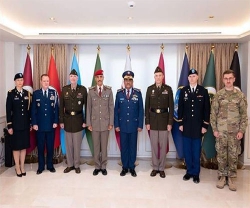Indra has reached an agreement to include the Polytechnic University of Madrid (UPM) in the Industrial Plan for the PROTEC Program launched to develop and integrate the sensors for the Spanish Navy’s future F110 frigate.
The deal was formalized through the signature of a partnership agreement with the UPM Rogelio Segovia Foundation for the Development of Telecommunications (Fundetel) and the Indra-UPM Research Chair at the university’s Faculty of Telecommunications Engineering.
The works will commence this year and will last until 2019. The first areas of collaboration that have been identified are related to the analysis, design and development of elements for the identification friend or foe (IFF) system, the X-band radar for the surveillance of surface and low-flying aerial targets, and the radar electronic support measures (RESM) system.
Indra will start working with the UPM Radiation, Microwave and Radar groups, with which it has collaborated in other projects in the past.
Other areas of collaboration under the auspices of the agreement will be determined in later stages of the PROTEC F110 program.
The agreement enables Indra to forge ahead with the Industrial Plan associated with the PROTEC F110 program in which it is acting as the driving organization for reinforcing the business fabric and developing research centers at Spanish universities.
The company will therefore help shine the spotlight on the expert knowledge of university professionals who work in highly specialized fields. For the UPM, it is an opportunity to participate in a cutting-edge technological project which will help it consolidate work and research groups that have experience in and knowledge of the development of the technologies of the future.
The agreement highlights the benefits to be gained from university-business collaboration in the development of highly complex technological solutions.
Indra and Navantia are working closely together in the PROTEC F110 R&D program to equip the Spanish Navy's new frigate with a novel mast that will house all of the vessel's sensors. These will be composed of flat elements to lower the radar cross section, making them harder to detect. Meanwhile, the high level of digitalization involved will significantly enhance their functions and performance.
Indra’s input in the program consists in developing the primary radars for both aerial and surface surveillance; the secondary radar or IFF system; the radar electronic support measures and communications systems, and their countermeasure systems to protect the vessel; and the Link 16 communications system. All of these systems will be integrated into the Navantia SCOMBA combat system.
The development of these sensors entails considerable R&D because they will incorporate the most advanced technology to ensure that the systems remain state-of-the-art throughout the entire useful life of the vessel. Moreover, their development is closely in line with the technology demanded in the most advanced international markets.
Indra is one of the main global consulting and technology companies and the technology partner for core business operations of its clients businesses throughout the world. It offers a comprehensive range of proprietary solutions and services.
Indra is a world leader in the development of comprehensive technological solutions in fields such as Defense & Security, Transport & Traffic, Energy & Industry, Telecommunications & Media, Financial Services and Public Administrations & Healthcare. Through its Minsait unit, Indra provides a response to the challenges of digital transformation.
Indra has a local presence in 46 countries, and delivered projects in more than 140 countries.






















